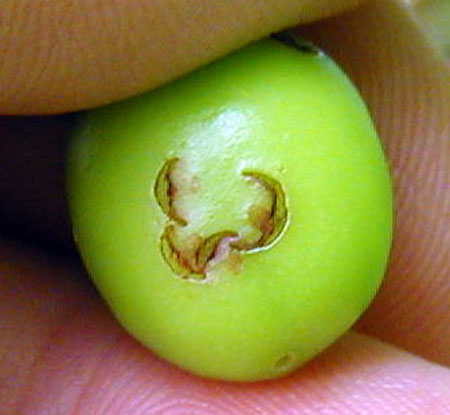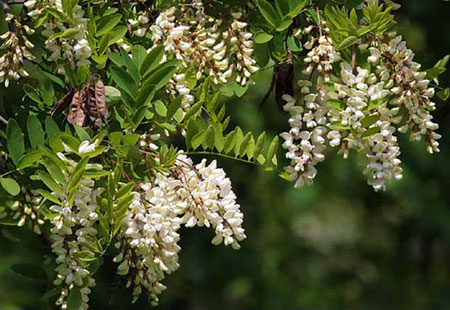Southwest Michigan fruit regional report – May 28, 2013
Wet, cool weather slows down fruit crops and insects in the southwest region.
Weather
What a change! Last week started near 90 degrees Fahrenheit. A cold front dropped temperatures to 80 on Tuesday (May 21), 70 on Wednesday (May 22) and mid- to upper 60s for the rest of the week. Friday (May 24), Saturday (May 25) and Sunday (May 26) mornings we had temperatures near 30 (according to Enviro-weather) with scattered frost, which caused little damage. Many growers ran sprinklers in strawberries and some blueberries. Midweek was cool and rainy. Intermittent rain showers Tuesday through Thursday (May 21-23) dropped 0.6 to 2 inches of rain. A lot of plants really needed that water and a break from the heat. It was too hot, too fast. Cool, dry weather prevailed from Friday through Sunday (May 24-26). Monday (May 27) was cold and rainy with a high in the mid-50s. Check your local weather station and conditions at Enviro-weather.
Southwest Michigan GDD summary from March 1 to May 26
|
Station |
GDD 42 F |
GDD 45 F |
GDD 50 F |
|
Benton Harbor (SWMREC) |
678 |
559 |
397 |
|
Fennville (TNRC) |
603 |
491 |
336 |
|
Average for the region |
678 |
559 |
393 |
Tree fruit
Tree fruit across southwest Michigan look good. Rains on Wednesday last week were favorable for many diseases including apple scab, fire blight, pear scab, cherry leaf spot and brown rot of stone fruit. Rains Monday and Tuesday this week were the start of new infections for scab and cherry leaf spot. Insect activity is increasing. Plum curculio egglaying damage is easy to find. Oriental fruit moth and codling moth trap catch are strong.
Apricot fruit are about an inch in diameter.
Peach fruit are about 12 to 18 millimeters in diameter. Fruit set looks excellent in most sites. Oriental fruit moth biofix was set for May 9, but some areas should reset to May 14 due to the freeze. Trap catches have generally been strong for the past two weeks across the region. We are now at 275 GDD base 45, and well into the egg hatch period. Developing fruit are susceptible to bacterial spot and rusty spot (powdery mildew) until approximately pit hardening. Peach leaf curl symptoms can be found throughout the area, but relatively light.
In cherries, cherry leaf spot infection occurred Wednesday last week and Tuesday this week. Exposed fruit is susceptible to plum curculio egglaying.
Sweet cherries are 14 millimeters in diameter and the pits are hard. They should be protected against plum curculio and cherry leaf spot. Sweet cherries are always susceptible to brown rot.

Multiple plum curculio egglaying scars on sweet cherry.
Photo credit: Mark Longstroth, MSU Extension
Tart cherries are about 12 millimeters and the pits are at first hardening. Two distinct sizes of fruit are visible. Growers should be protecting against plum curculio and leaf spot. Crop potential still looks good for many farms, with the exception of some areas near Berrien Springs, Mich., and Lawrence, Mich.
Plums are 12 millimeters (Stanley) and 15 millimeters (Methyl) at the Southwest Michigan Research and Extension Station (SWMREC). Growers should be protecting against plum curculio and black knot. Black knot controls are needed until active shoot growth slows in early to mid-summer. Fruit out of the shuck are prone to direct damage by plum curculio and bacterial spot.
Apples are 12 to 16 millimeters in diameter. Fruit set appears heavy. June drop should be apparent by the end of the week. Many growers will need to apply thinners soon (see the Michigan State University Extension article “Apple thinning pointers for 2013”). Warm, wet weather this week should be a good thinning window, but growers may want to reduce rates due to the high temperatures.
Fire blight blossom blight symptoms should be showing up from the May 9 infection event and heavy rains this week should spread the disease. Apple scab and powdery mildew are the diseases of concern at this time. These rains should release large numbers of scab ascospores. Scab symptoms, likely from the May 9 infection, can be seen in unsprayed trees.
Apples are also susceptible to plum curculio and tarnished plant bug. Overwintering obliquebanded leafroller larvae have been feeding and webbing on shoot tips and flower clusters, with flight of the next generation expected to begin about three weeks after petal fall. Codling moth males have been caught in area orchards and we set a biofix for May 18 (see the MSU Extension tip sheet “Codling moth in apples and pears”). Spray timing can be calculated from the codling moth model on Enviro-weather – be sure to note the insecticide recommendations below the model. Based on the May 18 biofix, egg hatch for this insect is expected this week using the SWMREC Enviro-weather data. Spotted tentiform leafminer mines are apparent.
Pears fruit are approximately 16 millimeters in diameter. Growers should continue to protect against pear scab and scout for fire blight and pear psylla activity.
Small fruit
In grapes, cool temperatures over the last few days have slowed growth just short of bloom for many cultivars. ‘Concord’ and ‘Niagara’ are at pre-bloom at SWMREC. ‘Chardonnay’ and ‘Riesling’ have 8- to 14-inch shoots, and ‘Cabernet franc’ has 10- to 14-inch shoots. ‘Marquette’ is at pre-bloom. The table grapes, ‘Mars’ and ‘Marquis’, are at pre-bloom.
Grape berry moth adult numbers continue to increase, but numbers are still light. The first generation of grape berry moths overwinters as pupae in leaf litter around vineyards and emerges before bloom. The grape berry moth model tracks the predicted percentage of egglaying for grape berry moths and predicts the start of second, third and fourth generation egglaying (810, 1620 and 2430 GDD base 47 F from the biofix of wild grape bloom respectively).
We reached biofix for grape berry moth in some parts of Berrien County on May 27 and expect to reach it in the rest of Berrien County and in Van Buren County in the next couple of days. Biofix is calculated as 50 percent bloom on 50 percent of flowers of wild grape (Vitis riparia).
Black locust is at full bloom right now. The black locust tree (Robinia pseudoacacia) grows at woods edge and is highly visible when in bloom. Its showy clusters of fragrant, white, pea-like flowers make a good reminder to check wild grape, which is usually at early to full bloom at the same time to determine the biofix stage for grape berry moth.

Black locust at early to full bloom is a good indicator plant for
wild grape bloom grape berry moth biofix stage.
Photo credit: Diane Brown, MSU Extension
As we approach bloom in grapes, the importance of timely fungicide applications with good coverage increases if diseases are to be well managed. We found the first spots of phomopsis on ‘Cabernet franc’ last Monday, and have been seeing more of it on other cultivars lately. Although temperatures have been cool, we have had sufficient hours of leaf wetness to trigger infection by phomopsis. Once we reach optimum temperatures in the 60s and 70s, it takes only six to 10 hours of leaf wetness to provide sufficient time for phomopsis to infect shoots and leaves.
The weather has been a little cool for black rot, but with temperatures in the 70 to 80 degree range, infection requires on six to seven hours of leaf wetness. Consult the 2013 Michigan Fruit Management Guide (E154) for recommended fungicides. Downy mildew needs five hours of leaf wetness at 50 F, three hours at 70 F and two to three hours at 80 F. Powdery mildew control should be applied now for problem areas or highly susceptible varieties. At pre-bloom, begin checking leaves inside the canopy closest to the trunk for powdery mildew. Powdery mildew is favored by high humidity and temperatures in the 68 to 81 F range.
Blueberries are at petal fall. Bloom is ending in early varieties. ‘Bluecrop’ and other varieties such as ‘Jersey’, ‘Ruble’ and ‘Elliott’ are past full bloom. Bloom in many fields is heavy. Cool weather the last week has caused blueberry leaves to redden. This red coloration will go away when warm weather returns. Rainy periods last week were poor pollination conditions.
The disease focus early in bloom is on mummy berry. Protectants are applied at early bloom and again at full bloom. Rains during bloom – especially warm rains – are good conditions for anthracnose and other fruit rot diseases. The Anthracnose Disease Prediction Model Handout posted at the Michigan Blueberry Facts website explains how to use the anthracnose prediction model on Enviro-weather. Later bloom sprays should focus more on protecting green fruit from anthracnose and phomopsis using fungicides with a different mode of action (FRAC code). Also, see the Blossom Blights in Blueberries handout with color photographs at the Michigan Blueberry Facts website.
Cherry and cranberry fruitworms are both flying. Cherry fruitworm biofix was May 15 in many areas in southwest Michigan. Cranberry fruitworm was caught in good numbers last week. A cranberry fruitworm model for timing the application of controls is available on Enviro-weather (see Fruitworms in blueberry control options”).
The use of Intrepid is restricted in Allegan County to areas further than a mile from wild lupines. MSU Extension recommends growers avoid all pesticide sprays of blooming blueberry fields during the day when bees are foraging. Try to finish any pesticide sprays, even bee-safe materials, early in the morning, so bees are not actually sprayed.
Strawberries are still blooming and early fruit are thimble-sized. Under this wet condition, fungicides are import to reduce diseases later in the season. See the 2013 Michigan Fruit Management Guide (E154) for fungicide recommendations.
Growers need to scout and treat for tarnished plant bugs (see “Managing tarnished plant bug injury to strawberries”). Everbearing strawberries in the high tunnels suffered minor freeze damage, but still have many berries. Powdery mildew has shown up on several research cultivars that seemed sensitive last year. This disease has not appeared on the commercial cultivars.
Brambles have begun blooming on floricanes. Orange rust-infected plants should be removed. Fungicides recommended for orange rust in the 2013 Michigan Fruit Management Guide (E154) will only prevent new infections.
Upcoming meetings
The next Monday fruit IPM meeting is on June 3 at Fruit Acres Farms at 5 p.m. These weekly meetings are good for one RUP credit and will continue through the end of June.
Weed Identification and Management for Vineyards workshops will take place June 6 (southwest Michigan) and June 7 (northwest Michigan). These half-day workshops will cover weed identification and management in grapes.



 Print
Print Email
Email
